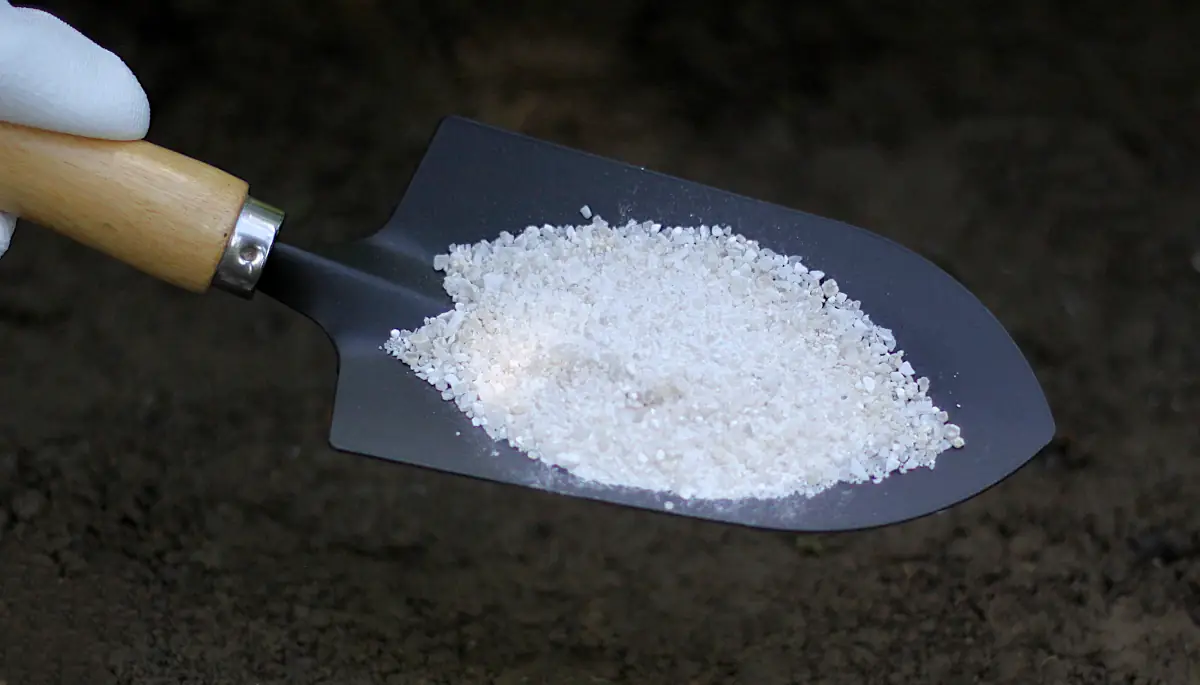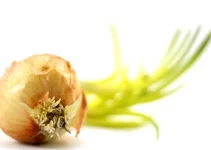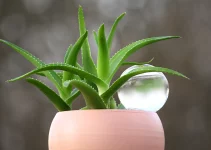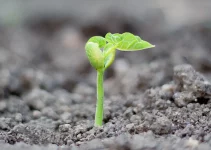Fertilizers low in nitrogen are necessary in two main situations.
Some of you might need a low or even zero nitrogen level if your soil has too much nitrogen and you don’t want to add more of it when using a fertilizer.
However, I believe that most of us look for low nitrogen fertilizer in a more specific situation: when our plants are moving on from the vegetative stage into the budding, flowering and ripening growth stages.
When we want our fruits to grow, that’s when we ditch the nitrogen in large quantities.
If we only want to grow a rich foliage, like if we’re growing herbs, lettuce, spinach, kale and other leafy greens, then our focus will be on higher nitrogen and lower phosphorus and potassium amounts. The same goes for lawn grass.
Fertilizers have three numbers written on them, like 20-20-20, 10-10-10 or 14-14-14 for an all-purpose fertilizer that can be used at any time during the plants’ growth stages and they can be used for a wide variety of plants. I also mentioned that when I recommended the best fertilizer for magnolia tree.
First number is the N (nitrogen), second is the P (phosphorus), and third is the K (potassium). And that’s how we get the NPK ratio. Potassium is also called potash.
A fertilizer low in nitrogen will have a small first number, followed by two bigger ones, like 1-12-6 to give you some random numbers. That means that it has 1% nitrogen by weight, 12% phosphorus by weight, and 6% potassium by weight. The rest of the weight is called filler.
Besides recommending the best fertilizers with a low concentration of nitrogen, I’ll also talk about the situations when we need such a specific product.
Table of Contents
My Favorite Fertilizers Low in Nitrogen

As you saw, it’s very easy to recognize a fertilizer low in nitrogen by the numbers written on the packaging. The first one should be the smallest, the focus will be on higher quantities of phosphorus and potassium.
Other low nitrogen fertilizers can be identified by names like: bloom, bloom booster, big bloom, bud & bloom booster, etc.
Tomato fertilizers will contain a good concentration of nitrogen but they also contain more phosphorus and sometimes even more potassium.
Those for tomatoes can also be used on other plants that produce fruits, like eggplants, cucumbers, peppers and even potatoes. Their NPK ratios can look something like this: 12-15-30, 4-6-3, 6-18-6, 5-7-3, etc.
We also get the option to buy fertilizers whose first number is 0. That means that they don’t contain any nitrogen at all, zero.
1. Down to Earth Organic Bone Meal Fertilizer, 3-15-0: One of the Best Fertilizers Low in Nitrogen
Bone meals are made from exactly what their name suggests, defatted, dried animal bones that are ground to a fine powder.
The thing with bone meal fertilizers is that you can be sure of one thing: they have 0 or very low nitrogen.
In fact, they’re used as a mineral supplement that is high in calcium and phosphorus. 0 potassium for all.
That’s why this Down to Earth Organic Bone Meal Fertilizer has a 3-15-0 NPK ratio. We also get 18% calcium.
It is recommended as a source of readily available phosphorus and calcium.
It can be used for flowering plants, trees and ornamentals. It’s also good when planting bulbs.
The effects of using the Down to Earth Organic Bone Meal Fertilizer is that it promotes strong root development and enhances early season growth.
Pretty much the focus of this one is on strong root development because it makes the plants grow faster and be healthier as they can absorb more water and nutrients.
Since it has such a high phosphorus concentration, it’s wonderful for the budding, blooming of plants, whether they’re flowers or plants that produce fruits (tomatoes, cucumbers, peppers, etc.).
We can use it for bulbs, to prepare new gardens, for new transplants, and on established plants. It has a wide scope and the instructions are easy to follow. We’re getting separate instructions for bulbs, vegetable gardens and flower beds, containers, and trees & shrubs.
Buyers use it for potatoes, for their entire vegetable garden, for roses and other flowers, trees and shrubs.
All in all, bone meal is one of my favorite fertilizers low in nitrogen because it makes our vegetables grow better than ever.
2. JR Peters Blossom Booster Fertilizer, 10-30-20
This is a 10-30-20 fertilizer that is designed to produce more flowers and brighter colors on all indoor and outdoor plants.
It’s mainly used for flowering plants like geranium, begonias, orchids, violets, etc.
However, it’s also used for all types of garden vegetables and fruits. We can use it on shrubs like raspberry, blackberry, blueberry, etc.
We can also use it for fruit trees.
Plus, we can use it as a transplant solution.
Once again, we’re talking about another highly versatile fertilizer but it might not be as low on nitrogen as you might want. Personally, I would say that it’s great.
We are advised to use it during periods of bud set to increase the number and size of blossoms.
The instructions are some of the simplest. If you want a plant food with the simplest instructions, you’re really going to love this JR Peters Blossom Booster Fertilizer.
To sum up the instructions, use 1 tablespoon per gallon of water for outdoor plants and ½ teaspoon per gallon of water for indoor plants.
We should apply it every 7-14 days when we’re doing a thorough watering. And that’s all we have to do for our flowers, shrubs, trees, vegetables, etc.
3. Dr Earth Organic Tomato, Vegetable & Herb Fertilizer, 4-6-3
One thing we can assume about tomato fertilizers is that they have higher levels of phosphorus.
Thus, this Dr Earth one is a 4-6-3. It also has a high concentration of calcium.
However, I love the fact that it’s organic.
It is derived from fishbone meal, bone meal, feather meal, alfalfa meal, potassium sulfate, fish meal, kelp meal, rock phosphate and kelp flour. Only wonderful ingredients.
Plus, it’s pretty all purpose since we can use it on pretty much all our vegetables and herbs.
It really is an amazing product to have around, no matter what we grow in our vegetable gardens or containers or garden beds.
Another thing that this manufacturer manages to surprise me with is that there are tailored instructions based on what we’re growing.
We get separate instructions for tomatoes, peppers, herbs, carrots, onions, beets, potatoes, leafy greens, corn, beans, cucumbers, eggplants, etc.
I really like that the instructions are also separate for new plantings and for established plants.
That tells us that we can use this Dr Earth Organic Tomato, Vegetable & Herb Fertilizer from start to finish. We don’t have to use one type for seedlings and the vegetative stage and then switch to another for the budding and flowering.
I love the convenience that this Dr Earth can offer to growers.
4. Botanicare Cal-Mag Plus, 2-0-0
This is not a fertilizer in the proper sense so it might not be what you’re looking for but I still wanted to tell you about it. You’ll still have to use a separate fertilizer as plant food.
The Botanicare Cal-Mag Plus is a calcium, magnesium and iron supplement.
Besides, N, P and K, plants need different micro and macronutrients to prevent disease and deficiencies so that they can grow strong and healthy.
For example, most buyers get this supplement to prevent blossom end rot.
If you have a past where tomato fruits were sacrificed to blossom end rot, you’ll love this.
Thus, this product targets growers who have encountered different deficiencies in the past.
The Botanicare Cal-Mag Plus can be used in containers, coco, hydroponics, and soil. It’s universal.
It comes with very easy to follow instructions, the quantities recommended are based on plant growth stages: seedlings/clones, vegetative, bloom transition (budding), and flowering/fruiting. That’s the stage where the feedings, which are done weekly, stop.
It can also be used as a foliar spray to enhance growth. For example, you can spray it onto flowering plants or trees like lemon trees, bonsai trees, oleander trees, on shrubs, etc.
5. Dyna-Gro Bloom Liquid Plant Food, 3-12-6
When I talked about the best hydroponic nutrients, I mentioned that Dyna-Gro is one of those manufacturers that makes their fertilizers universal, both for being used in hydroponic systems and for soil cultures.
Moreover, the instructions for their products are really easy to follow. Users love how easy they are to use, whether they’re growing indoors, outdoors, in hydroponics, in soil, in garden beds, etc.
This Bloom Liquid Plant Food should be used when plants start budding and continue using it through flowering/fruiting. You can stop using it entirely during ripening because only water and light/warmth is needed at this stage.
You can also add it to your flowers if you want to look at the most beautiful and abundant blossoms your plants have ever grown.
For indoor plants, mix ¼ to ½ tsp per gallon of water with every watering.
For outdoor plants, mix ½ tsp per gallon of water with every watering. However, if you just want to do a monthly feeding, mix 1 tsp per gallon of water.
If you’re using it for hydroponics, mix 2-3 tsp per gallon of water for a recirculating system (NFTs, drips, ebb and flow, aeroponics) or 1 tsp per gallon of water for non-recirculating systems (Kratky method, DWC, wicks, indoor hydroponic gardens).
It can also be used in an irrigation injector.
6. Alaska Morbloom Concentrate, 0-10-10
People looking for 0 nitrogen in their fertilizers are going to want to check this one out.
It is recommended for abundant colorful flowers.
The Alaska Morbloom Concentrate is described as being capable of stimulating budding and blooming and promoting vigorous root growth.
It is also made with natural based fish so it’s an amazing choice for those who enjoy fish fertilizers, which are also organic.
It can be used on all flowering plants.
7. Grow More Water Soluble Fertilizer, 0-50-30
This is a 0-50-30. It’s great for those who are looking for 0 nitrogen in their fertilizers.
People use it to get great results for their lawns but others also use it for vegetable and tree growth.
It is described as being formulated to supply sufficient amounts of extra nutrients for high yields.
Thus, if you’re looking for products that are used in the budding and flowering/fruiting stages, the Grow More Water Soluble Fertilizer can work well for you.
But that also implies that your soil has more than enough nitrogen to supply to your plants because they need N through all their growth stages, including budding and flowering, albeit in smaller quantities, while phosphorus and potassium take over.
How Low Nitrogen Fertilizers Are Used
In order to know how to use any fertilizer, I recommend checking out the instructions that are written on the packaging.
Each manufacturer will have its own instructions on how their product should be used, based on the plants you’re using it on.
Most fertilizers are water soluble so you just dissolve the instructed quantity in water and water your plants with it thoroughly. Most will be used once every 7-14 days.
Granular fertilizers are slow release so those have to be incorporated into soil about every 6-8 weeks. Even a single application can be enough for the entire growing season so they’re convenient in that respect.
When Fertilizers Are Used According to Plant Growth Stages
If we were to get very technical about our use of fertilizers and their respective NPK ratio, we would follow a schedule according to plant growth stages.
If you are interested in knowing everything about plant growth stages, I recommend this article from earthjuice.com.
Germination doesn’t need any fertilizer because seeds contain all the nutrients they need to grow into seedlings.
1. Using compost and manure in the gardens
Way back in the past, the only way people had to enrich their soil with nitrogen was to till it with manure. Nowadays, we certainly have so many choices that we don’t even know what to choose.
If we’re growing in gardens, most of us will till manure and compost into the soil in the fall or winter.
That way, we also ensure a good supply of nitrogen to the soil for the spring planting. And that’s how we might find ourselves looking for the best fertilizers low in nitrogen.
People who use organic fertilizers might also prefer adding a few to the soil before sowing the seeds. Or when they’re transplanting seedlings.
Compost is a clear example of such an organic fertilizer but we might also like using fish fertilizers or other organic options.
2. Fertilizing seedlings
Once the seedlings have grown true leaves, we can start using a balanced fertilizer or one that has a higher nitrogen concentration.
For example, for tomato plants, we would first fertilize them when we would transplant them into the soil or into bigger containers where they will grow as mature plants that produce fruits.
3. Vegetative stage (when we need nitrogen)
This is actually the stage where nitrogen is the important component in the NPK ratio. But if we use an all purpose 20-20-20 fertilizer that’s good, too.
Nitrogen is actually the most important component for supporting plant growth. And that’s certainly important in the vegetative stage when plants develop their root system, stem and leaves systems.
Nitrogen is essential in the formation of protein.
Plants absorb this element more than any other.
Its role is crucial for leaf growth and the green color. It also ensures that plants grow healthy and nutritious for our consumption.
4. Budding (low nitrogen fertilizer needed)
Now, our plant starts to transition from the green growth towards producing buds, flowers and fruits.
Phosphorus becomes an important element in our NPK ratio. It promotes stem and leaf growth while encouraging buds and blooms.
Phosphorus helps plants grow roots and produce flowers, fruits, and seeds. It also helps them to use and store energy and to grow healthy.
Thus, we can now switch to our fertilizers low in nitrogen, if you haven’t used one right from the seedling growth stage because your soil is already rich in manure, compost or a combination of both.
5. Flowering (low nitrogen fertilizer used)
Potassium is the star of the show in the flowering stage. It’s the element that offers significant support for flowering, fruit producing and plant health.
But it’s also needed in the vegetative stage because it’s the protector, ensuring plants resist disease, and it’s responsible for the growth rate.
6. Ripening (no fertilizer)
At this point, plants need water and warmth for their fruits to grow the right size and to ripen. Thus, we end our journey with fertilizers low in nitrogen here, at the ripening growth stage of our plants.




